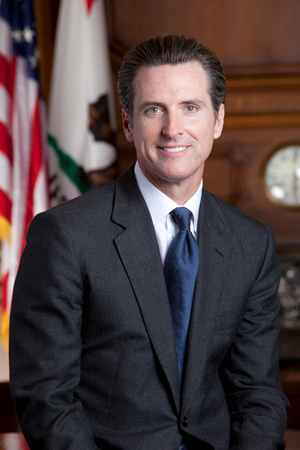
When PG&E turned off the power, the State of California mobilized every corner of government to protect residents
State health, emergency, business & other agencies deployed resources, partnered with non-profits, labor and private industry to identify & assist vulnerable residents and communities
November 19, 2019 - SACRAMENTO – On Monday, members of the Newsom administration testified before the Senate and told how state government – when faced with extreme Public Safety Power  Shutoffs (PSPS) by PG&E in October – flew into action to protect residents and communities.
Shutoffs (PSPS) by PG&E in October – flew into action to protect residents and communities.
“Faced with the unprecedented decision by PG&E to leave millions of Californians without power, the State of California sprung into action to protect vulnerable residents,” said Governor Gavin Newsom. “In this time of crisis, Californians joined together to help identify and assist those who would be most at risk during long periods without power. California agencies partnered with local leaders, non-profits, labor unions and private industry to deploy resources to communities most in need. Our world-class emergency responders and emergency agencies battled on multiple fronts – dangerous fire conditions and PSPS. Through prepositioning of firefighting assets and mobilizing emergency response systems, California was able to avoid the major loss of life that has occurred under similar conditions.”
All state agencies were activated in the State Operations Center at the California Office of Emergency Services (CalOES) to ensure continuity of critical infrastructure across the state. OES activated the state operations center to its highest level to manage the dual threat of wildfires and the power shutoffs. CalOES and CAL FIRE pre-positioned assets statewide to prepare for the emergencies, with the California National Guard on standby to assist. Teams from the California Highway Patrol worked around the clock to protect Californians traveling on our state’s roads while Caltrans also worked to keep those roads, as well as rails and tunnels, open.
The Governor also launched a $75 million program to help state and local governments mitigate the impacts of power shutoffs and a new resource site, RESPONSE.CA.GOV, to serve as a one-stop portal for resources available to Californians impacted by wildfires and power shutoffs.
Ensuring Care for Medically-Vulnerable Californians
The Administration also focused its efforts on protecting the health of the most vulnerable Californians, who would be disproportionately affected by power shutoffs. Governor Newsom created a Public Safety Power Shutoff Planning Team at the California Health and Human Services Agency (CHHS). The team worked across sectors with members from local government, labor organizations, and health care providers to coordinate outreach to those who were dependent on life-saving medications and medical devices. CHHS also established a partnership with Service Employees International Union (SEIU) and United Domestic Workers (UDW), to ensure that In-Home Supportive Services (IHSS) providers had the information they needed to provide care and do wellness checks on vulnerable seniors and people with disabilities.
CHHS also created a power shutoff hotline for medically-vulnerable Californians and health and community care facilities so they could easily find resources in their communities. CHHS also created a data dashboard for local response partners to allow local governments, state agencies, and community partners to share information to better plan and respond to power shutoffs. CHHS also helped those with access and functional needs be prepared for power shutoffs by creating an online tool to create a personal emergency plan.
Strategic Prepositioning of Assets to Provide Emergency Response and Medical Aid
The Newsom administration worked to strategically place first responders in impacted areas to serve Californians’ health needs. Cal OES Fire and Rescue staff coordinated with counties to preposition fire apparatus and personnel to augment local resources in preparation for significant weather events, allowing teams to quickly mobilize. CHHS also deployed 41 ambulance strike teams, each team comprised of five ambulances and one leader vehicle, across the state to support individuals with power-dependent health equipment and be on standby to transport sick or injured individuals to hospitals. When evacuation centers were activated, the California Department of Public Health had a team visit each shelter to ensure appropriate infectious disease protocols were in place and prepositioned necessary medications in the event of an influenza outbreak.
Protecting California’s Consumers and Workers
When the Governor declared a state of emergency, he ensured that protections from price gouging on housing, gas, food, and other essential supplies, were in place for 30 days. His Administration also worked to lower the impacts of power shutoffs on food insecure families, making sure that families enrolled in CalFresh were eligible for food replacement if they had to throw away any food. The Governor also held utilities accountable to provide resources in response to community needs through the establishment of utility-run resource centers and providing blankets and ice as they became necessary during the course of the shutoffs.
Governor Newsom directed the Employment Development Department (EDD) to waive the standard one-week waiting period for individuals to receive their unemployment benefits if their employment was impacted by extreme weather events. EDD also sent staff to the most utilized community resources centers to help Californians apply for benefits. The Newsom administration also worked to ensure worker safety in wildfire regions, advising employers on mandatory worker protections to limit harmful exposure to wildfire smoke.
The Governor’s Office of Emergency Services (CalOES) directed telecom companies to fix gaps in their broadband coverage, leading to those companies providing prepaid phones, hotspots, routers, and waived fees on data overage.
Supporting Small Businesses Impacted by Power Shutoffs
The Governor’s Office of Business and Economic Development (GO-Biz) created a resource guide for businesses impacted by power shutoffs and leveraged low interest loan programs to help provide resources for businesses affected by the power shutoffs. Google, Facebook and Yelp worked with Cal OES to highlight business hours of companies that were open for business, and encouraged Californians to patronize those businesses. GO-Biz and Visit California continue to work together to encourage Californians to support small businesses affected by wildfire and power shutoffs through a coordinated campaign through the holiday season.
Marshalling Corporate and Philanthropic Aid
Corporations and philanthropic organizations joined the Governor’s efforts offering early financial support for those affected by California fires, raising over $10 million for the effort. Companies like Apple, JPMorgan Chase, Google, Facebook, Kaiser Permanente, Ripple, Paramount Pictures, Adobe, AT&T and others made donations to various nonprofits and community organizations serving impacted Californians. The Governor’s Office, California Volunteers and Cal OES worked closely with Philanthropy California, the umbrella organization for foundations throughout the state, to vet and post relief funds to support those most affected by fires.
Additionally, companies stepped up to provide additional resources for those impacted, including Airbnb offering over 2,500 homes to those who needed to evacuate. Technology companies also worked with Cal OES, CAL FIRE, and first responders to develop a new wildfire map product, community safety check features, and create new functionality in their applications to show fuel availability.
Demanding Accountability of PG&E
As state agencies were focused on the immediate task of saving lives and assisting residents, Governor Newsom demanded accountability – calling on the California Public Utilities Commission to reform power shutoff rules and regulations as part of its investigation into the utility-led shutoffs and demanding PG&E credit customers impacted by their overly-broad PSPS. Last week, the CPUC announced it would be moving forward with an investigation into PSPS with the potential for enforcement actions. PG&E also announced the company would acquiesce to Governor Newsom’s demands that they provide rebates to customers impacted by their overly-broad PSPS.
Here are all the ways that the State of California mobilized the resources of state government to help Californians during last month’s PSPS:
Supporting Vulnerable Californians
- The California Department of Health and Human Services (CHHS) convened health plans to ensure they were tracking response efforts and reaching out to vulnerable beneficiaries.
- California Department of Social Services (CDSS) obtained Federal Government authority to issue mass benefit replacement for residents suffering food loss.
- CDSS worked with counties to check on Adult Protective Services clients and foster children.
- The California Department of Aging (CDA) worked closely with the Area Agencies on Aging to check on older residents and ensure they received services.
- The California Department of Rehabilitation (DOR) worked closely with Independent Living Centers to ensure those with disabilities were checked on and received services.
- The In-Home Supportive Services Program at CDSS worked with unions to check on IHSS providers.
- The Emergency Medical Services Authority (EMSA) ensured adequate transportation to repopulate hospitals and health facilities and deployed ambulance strike teams to support individuals with power-dependent health equipment.
- CHHS convened county colleagues to ensure coordination and provide all necessary resources to affected individuals in the region, providing data to ensure they were tracking the most vulnerable in the impacted regions.
- The California Department of Community Services (CDS) activated the Low-Income Home Energy Assistance Program Severe Weather Energy Assistance and Transportation Services Program, allowing authorization to provide emergency transportation, shelter and power-generating equipment to impacted low-income families and individuals.
- CHHS convened an Access and Functional Needs Workgroup to help guide efforts and coordinate messaging and outreach to individuals who are dependent on life-saving medications and medical devices.
- The Governor’s Office and the Office of Emergency Services (Cal OES) worked with community-based organizations to support the unique needs of immigrant and mixed status families.
- The Employment Development Department (EDD) allowed workers who lost work due to extreme weather events to apply for benefits immediately. The Governor waived the one-week waiting period suspension for unemployment insurance benefits. EDD also sent crews to five of the most-utilized community resource centers to help people apply for Unemployment Insurance.
- The California Department of Labor provided grants for additional assistance to migrant and seasonal farmworkers (MSFW) and is developing outreach for future emergencies and services to MSFW populations.
- The Governor’s Office issued an emergency proclamation protecting against price gouging on housing, gas, food, and other essential supplies for 30 days.
Managing Shelters
- The California Department of Social Services (CDSS) managed all sheltering operations in partnership with counties and community partners, including the American Red Cross, building capacity among California shelters to house nearly 12,000 individuals.
- The California Department of Developmental Services (CDDS) collaborated with Regional Centers to ensure that evacuated clients were monitored and had their needs met.
- The Department of Health Care Services (DHCS) worked with the County Behavioral Health Directors Association (CBHDA) to ensure there were sufficient mental health providers in shelters.
- The California Department of Public Health (CDPH) visited each shelter to ensure appropriate infectious disease protocols were in place to avoid the spread of infectious diseases.
- The California Department of Food and Agriculture (CDFA) placed over 1,000 animals in shelters.
Keeping the State Functional
- The California Department of Education (CDE) coordinated with schools across the state to minimize disruptions, keep children in class, and continue school meal programs.
- The Department of Water Resources (DWR) secured the state water project to make sure water kept flowing to families, business and farmers.
- The Governor’s Office of Business and Economic Development developed a business resource guide with low-interest loan information and advisory services for businesses in the PSPS areas.
- CDFA provided support for farmers and food distributors to ensure they had the support needed to continue harvest and operations.
- The California Air Resources Board (CARB) worked with local air districts to adjust requirements on back-up generator use during PSPS events.
- As evacuation orders lifted and health facilities began the process of repopulating, inspectors from California’s Office of Statewide Health Planning and Development (OSHPD) were prepositioned in the regions to move quickly on inspections. CDPH was on standby to expedite surveys and provide approvals to health facilities to repopulate.
Informing Californians
- The state launched a new website to provide resources in response to shutoffs: RESPONSE.CA.GOV.
- CHHS activated a hotline for vulnerable individuals with access and functional needs, as well as health and social services facilities. The hotline was available in multiple languages, including Spanish. They also developed a new consumer webpage to find resources in de-energized areas and developed an online data dashboard of health care facilities and people with durable medical equipment for community partners, local governments and state agencies to better plan and respond to power shutoffs. To help individuals with access and functional needs plan for PSPS events, CHHS created a new online tool that allows individuals to complete a personal emergency plan.
- CHHS developed a prescription medication guide for those with medication needs – as well as a mapping tool to locate open pharmacies.
- CDSS developed tip sheets for both consumers and providers to make sure they are prepared for PSPS events.
- The state posted online resources on digital platforms, including videos in Spanish, Mandarin, Korean and Tagalog.
- The Governor’s Office of Emergency Services Listos California shared preparedness information with communities through social media, email, and neighborhood canvassing in partnership with Community Emergency Response Teams (CERTs) and Community Based Organizations (CBOs).
- The California Environmental Protection Agency (CalEPA) coordinated with local Air Quality Management Districts to monitor air quality and send out alerts as necessary. CDPH developed a new factsheet on air quality and mask use for impacted communities, including workers.
- The California Division of Occupational Safety and Health (Cal/OSHA) advised employers to protect workplaces and workers if the air quality is unhealthy due to wildfire smoke.
- The Office of Tribal Affairs (OTA) contacted all tribes and invited them to join operations calls; also coordinated three tribal Community Resource Centers in Humboldt (2) and Lake (1) counties.
- Agencies across government collaborated on public messaging promoting preparedness, promoting community resource centers, situational awareness and other resources.
Public Safety
- Cal OES activated the state operations center to its highest level in order to manage the dual threat of wildfires and PSPS.
- Cal OES and the California Department of Forestry and Fire Protection (CAL FIRE) prepositioned assets statewide to respond to emergencies.
- The California Highway Patrol (CHP) increased staffing security, traffic control and increased patrols in areas where the power went out. CHP also provided air assets to assist PG&E in power line safety inspections to expedite power restoration.
- The California Department of Transportation worked to keep roads, rail and tunnels open.
- The National Guard had personnel and equipment on standby at its facilities across the state, and made air assets available to PG&E in power line safety inspections to expedite power restoration, and support CAL FIRE in firefighting operations. Additional Cal Guard firefighting hand crews were on standby to assist in firefighting operations.
- The Department of General Services (DGS) provided emergency contracts to purchase emergency goods to support local and state response.
- The Department of Technology (CDT) embedded with PG&E to troubleshoot the utility’s technology challenges and worked to secure technology assets across the state to manage increased traffic due to PSPS.
- The Department of Fish and Wildlife deployed five Wildlife Law Enforcement Officers to assist with response to the Kincade Fire.
Source: Office of the Governor









